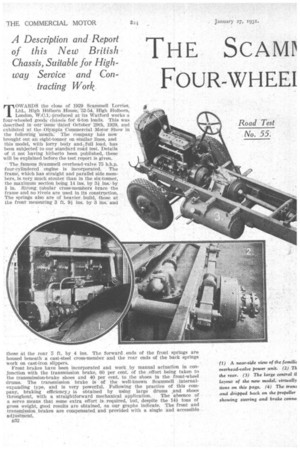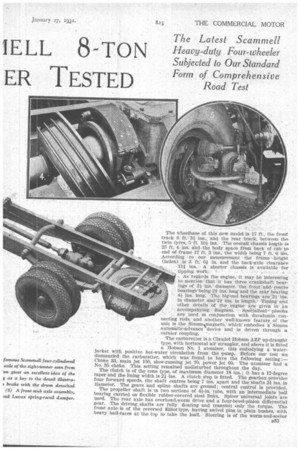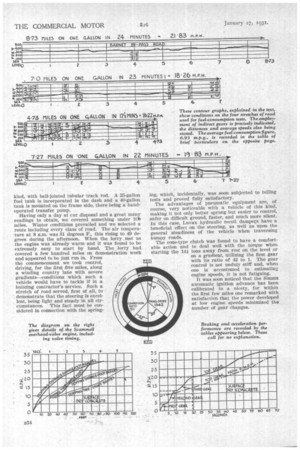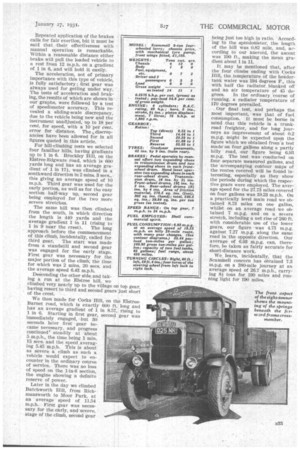THE SCAMP FOUR-WHEEL IELL 8-TON ER TESTED
Page 50

Page 51

Page 52

Page 53

If you've noticed an error in this article please click here to report it so we can fix it.
A Description and Report of this New British Chassis, Suitable for High way Service and Con tracting Work The Latest Scammeil Heavy-duty Four-wheeler Subjected to Our Standard Form of Comprehensive Road Test
TOirVARDS the close of 1929 Scammell Lorries, Ltd., High HOlborn . House, '52-54,' High Holborn, London, W.C.1,.-prodUced at its Watford works a four-wheeled goods chassis for 6,ton loads. This was described in mir-iSsue "dated October, 29th, 1929, and exhibited at the-Olympia Commercial Motor Show in the folloWing .`mbuth:-. . The 'ebnipan3r lids now brought out un,eight-tenner on similar lines, and this model; with lorry body and-full load, has been subjected' to our standard road test. Details of it not having hitherto been published, these will be explained before the test report is given.
' The famous Seammell overhead-valve 75 b.h.p. four-cylindered engine is incorporated. The franie; which has straight and parallel side members; is.v.ery much stouter than in the six-tonner, the maximum' section being 14 ins, by ai ins., by i in. SIrong: tubular cross-members brace the frame ancl_no 'rivets are Used in its construction. The springs also are of heavierbuild, those at the front, measuring 3 ft. Oi ins, by :3 ins: and
those at the rear 5 ft. by 4 ins. The forward ends of the front springs are housed beneath .a cast-steel cross-member and the rear ends of the back springs work on cast-iron slippers. Front brakes have been incorporated and work by manual actuation in conjunction with the transmission brake, 60 per cent, of the effort being taken to the transmission-brake shoes and 40 per cent. to the shoes in the front-wheel drums. The transmission brake is of the well-known Seammell internalexpanding type, and is very powerful. Following the practice of this company, braking efficiencyj is obtained by using large drums And shoes throughout, with a straightforward mechanical application. The absence of a servo means that some extra effort is required, but, despite the 14i. tons of gross weight, good results are obtained, as our graphs indleate. The front and transmission brakes are compensated and provided with a single and accessible adjustment.
B32 The wheelbase of this new model is 17 ft., the front track 6 ft.'3I ins., and the rear track, between the
twin tyres, 5 ft. 104. ins. The overall chassis letkthAs 25 ft. 4 ins, andthe body apace from back of Cab-to endof frame 17 ft. 3 'ins., the width being 7 ft.6' ins. According to Our' measurement the frame -height (laden) is 3 ft: Of in. and the back-axle clearanee 111 ins. A shorter chassis is available fOr tipping Work.
As regards the engine, it may be interesting
to mend that it has' three crankShaft bearings of 24 ,ins.; diameter the fi-ciat' and centre bea:rings'being 2f ins: long-and the rear bearing 44 ins. long. The big-end bearings are'.24
in diameter and:24 ins. in length.. Timing and other details of the_.eligine are given irt an accOmpatiYing diagram'. pistons are used in conjunction with duralumin connecting rods, and another _well-known feature, of the unit is the SimmsAmagneto,' Which' embodieS a Simms automatic-advance device and is driven 'through a vernier coupling. • The carburetter is a Claudel Hobson AZP up-draught type, with horizontal 'air strangler, and above it is fitted a Hobson No. 1 atomizer, this embodying a waterjacket with positive hot-water circulation from the pump. Before our test we dismantled the carburetter, which was found to have the following setting:— Choke 33, main jet 150, slow-running jet 70, power jet 60. The atomizer had a No 35 choke: This setting remained undisturbed throughout the day.
The clutch is of the cone type, of maximum diameter 18 ins.; it has a 12-degree taper and the lining width is 21 ins. A clutch stop is fitted. , The gearbox provides four forward speeds, the shaft centres being 7 ins, apart and the shafts2i ins. in diameter. The gears and spline shafts are ground; central control is provided. The propeller shaft is in two sections of 44-in. tube, with an intermediate ball bearing carried on flexible rubber-covered steel links. Spicer universal joints are used. The rear axle has overhead:woran drive and a four-bevel-pinion differential gear. The driving, shafts are fully floating and transmit only the torque. The front axle is of the reversed Elliot type, having swivel pins in plain bushes, with heavy ball-races at the top to take the loatl. Steering is of the worm-and-sector kind, with ball-jointed tubular track rod. A 25-gallon • fuel tank is incorporated in the dash and a 40-gallon • tank is mminted on the frame side, there being a handoperated transfer pump.
Having only a day at cur disposal and a great many readings to obtain, we covered something, under IG1) miles. Winter conditidns prevailed and we selected a route including every class of road. The air temperature at 8 a.m. was 31 degrees F., this rising to 49 degrees during the afternoon. When the lorry, met us
• the engine was already warm and it was found to be • extremely easy to start by hand. The lorry, had covered a few hundred miles on demonstration work and appeared to be just run in. From the commencement we took control, driving, for the first .five miles, along a winding country lane with severe
• gradients—conditions which such a vehicle would have to tackle if in a building contractor's service. Such a stretch of road served, first of all, to demonstrate that the steering is excellent, being light and steady in all circumstances. This fact must be considered in connection with the spring
Mg, which, incidentally, was soon subjected to telling tests and proved fully satisfactory.
The advantages of pneumatic equipment are, of course, very noticeable with a vehicle of this kind, making it not only better sprung but easier to control, safer on difficult ground, faster, and much more silent. In this case, Luvax hydraulic recoil dampers have a beneficial effect on the steering, as well as upon the general steadiness of the vehicle when traversing bumpy roads. The cone-type clutch was found to have a comfortable action and to deal well with the torque -when starting the 14i tons away from rest on the level or on a gradient, utilizing the first gear with its ratio of 42 to1. The gear control is not unduly stiff and, when one is accustomed to estirnatinz engine speeds, it is not fatiguing.
It was soon noticed that the Simms automatic ignition advance has been calibrated to a nicety, for Within the first few miles one remarked with satisfaction that the power developed at low engine speeds minimized the number of gear changes.
Repeated application of the brakes calls for fair exertion, but it must be said that their effectiveness with manual operation is remarkable. Within a reasonable distance either brake will pull the loaded vehicle to a rest from 12 m.p.h. on a gradient of 1 in 6, and will hold it easily.
The acceleration, not of primary importance with this type of vehicle, is fully satisfactory ; first gear was always used for getting under way. The tests of acceleration and brak ing, the results of which are shown in our graphs, were followed by a test of speedometer accuracy. This re vealed a sliding-scale discrepancy, due to the vehicle being new and the instrument unadjusted, up to 18 per cent, for speed, with a 10 per cent.
error for distance. The discrepancies have been allowed for in all figures quoted in this article.
For hill-climbing tests we selected four familiar hill.s, having gradients up to 1 in 6. Brockley Hill, on the Elstree-Edgware road, which is 600 yards long and has an average gradient of 1 in 17k, was climbed in a southward direction in 2 mins. 3 secs., this giving an average speed of 10 m.p.h. Third gear was used for the early portion, as well as for the easy section half-way up, second gear being employed for the two more severe stretches.
The same hill was then climbed from the south, in which direction the length is 440 yards and the average gradient 1 in 11 (rising to
1 in 9 near the crest). The long approach before the commencement of this climb, incidentally, called for third gear. The start was made from a standstill and second gear was engaged for the early stage. First gear was necessary for the major portion of the climb-, the time for which was 2 mins. 20 secs. and the average speed 6.43 m.p.h.
Descending the other side, and taking a run at the Elstree hill, we climbed very nearly up to the village on top gear, having resort to third and second gears just short of the crest.
• We then made for Cocks Hill, on the ElstreeBarnet road, which is exactly 600 ft.. long and has an average gradient of 1 in 8.57, rising to 1 in 6. Starting in first gear, second gear was immediately engaged, •hut 30
seconds later first gear became necessary, and progress continued* steadily at about 5 m.p.h., the time being 1 min. 15 secs, and the speed Averaging 5.45 m.p.h. This is about as severe a. climb as such a vehicle would expect to encounter in the ordinary course of service. There was no loss of speed on the 1-in-6 section, the engine showing a definite reserve of power.
Later in the day we climbed Batchworth Hill, from Rickmansworth to Moor Park, at an average• speed of 11.54 m.p.h. First gear was necessary for the early, and severe, stage of the climb, second gear being just too high iii ratio. According tO the speedotneter, the length of the hill was 0.82 mile, and, according to our aneroid, the ascent was 190 ft., making the mean gradient about 1 in 11.
It may he mentioned that, after the four climbs ending with Cocks the temPerature of the headertank water was 194 degrees F., this with half the radiator, blanked off and an air temperature of 45 de grees.the ordinary 'course of runnig, a radiator temperature of 170 degrees prevailed.
Our final test, and perhaps the most important, -was that of fuel consumption. It must be borne in mind that this vehicle -is a trunkroad freighter,. and for long Jour.neys an improvement of about0.2 in.g.g. might ' be expected upon the figure which we obtained from a test made' on four gallons along a partly hilly • road, our figure being 6.93 m.p.g. The test was conducted on four separate -measured gallons, and the accompanying contour maps of the routes covered will be found interesting, especially as they show the periods during which the respective gears were employed. The average speed for the 27.73 miles covered on four gallons was 19.23 m.p.h. On a practically level main road we obtained 8.73 miles on one gallon, whilst on an average road we obtained 7 m.p.g. and on a. severe stretch, including a net rise of 260 ft. with considerable use of the lower gears, our figure was 4.73 m.p.g. against 7.27 m.p.g. along the same road in.opposite direction. Our averag of 6.93 m.p.g. can, therefore, be taken as fairly accurate for short-distance work.
We learn, incidentally, that the Scammell concern has obtained 7.3 m.p.g. on a 380-mile journey at an average speed of 26.7 m.p.h., carrying 8i tons for 190 miles and running light for 190 miles.




































































































